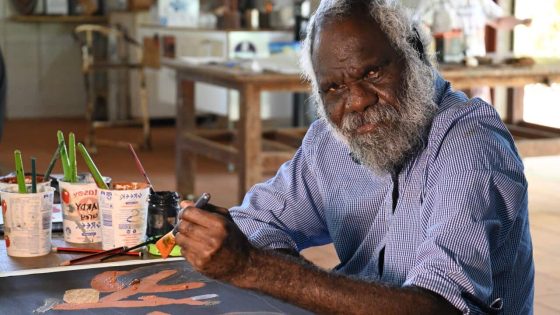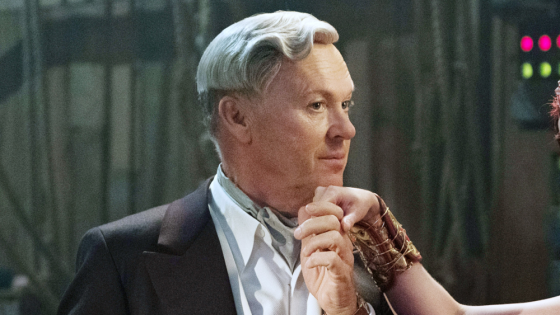Spokes, handlebars and frame: artist Alfonso Puautjimi maps out a bicycle on a backdrop of black with studied precision.
Heavily laden brush in hand, the 54-year-old applies coloured ochre in thick strokes.
It is a unique style that’s won him a coveted spot amongst 72 finalists in the National Aboriginal and Torres Strait Islander Art Award (NATSIAA), exhibited at the Museum and Art Gallery of the Northern Territory.
“There is this beautiful joy to his work,” NATSIAA selection panelist Rebekah Raymond explains.
“I think it’s that idea of taking a glimpse of something from the everyday, and then rendering it in beautiful natural ochres, it’s such a special thing.”
Alfonso Puautjimi’s “Grey Bike” is on display at the Museum and Art of the Northern Territory as part of the 2024 NATSIAA exhibition. Source: NITV / Laetitia Lemke
Alfonso Puautjimi paints from an NDIS-supported art centre in Wurrumiyanga on the Tiwi Islands, called Ngaruwanajirri.
“Ngaruwanajirri means helping one another,” Art centre chairman Ken Wayne Kantilla explains.
“[Alfonso Puautjimi] does very good work, he enjoys doing painting, same like all my clients,” he says motioning around the room to half a dozen other artists, who nod and respond ‘kuwa’, the Tiwi word for yes.
“Some of the [clients] have worked here a long time now … 30 years,” Mr Kanitlla says.
The bicycle that features in many of Alfonso Puautjimi’s creations belongs to Ngaruwanajirri co-founder Joy Naden. Source: NITV / Emma Kellaway
The bicycle that features in many of Alfonso Puautjimi’s work belongs to the centre’s co-founder Joy Naden.
“He’s been painting Joy’s bicycle for nearly the whole time he has been here,” Ngaruwanajirri manager Jane Polkinghorne says.
“That’s what he is really well known for, these really quirky bicycles.”
Natural ochre is collected from Tiwi Islands cliffs and mixed with glue to create paint. Source: NITV / Laetitia Lemke
Ex-teachers Joy and John Naden founded Ngaruwanajirri in the mid 90s.
“The centre was set up specifically to support artists in the community with disabilities,” Ms Polkinghorne says.
“It’s been running for 30 years and obviously that is well before the NDIS came about.”
The centre endured hard years when funding was scarce, and survived seemingly impossible years when there was no funding at all.
“There’s been some bumpy times in [Ngaruwanajirri’s] finances and obviously it’s really great to have the [National Disability Insurance Scheme] support the kind of work that is done here,” Jane Polkinghorne says.
It’s the artists and founders that kept Ngaruwanajirri alive.
Carvings and paintings on display at the Ngaruwanajirri Art Centre which is supported by NDIS. Source: NITV / Laetitia Lemke
A call of “morning tea” has artists filing outside to an open flame where tea brews in a large pot.
One by one artists and workers scoop a cup full and return to the centre where cake and biscuits are waiting.
Under a banner of traditional ancestral stories, hand-painted onto the art centre’s high dome ceilings, they eat, talk and laugh.
Support worker Gordon Pupangamirri sits on a long wooden bench next to Alfonso Puautjimi.
“I ask him to maybe try and say something to you,” Gordon Pupangamirri says, “but he just says ‘Kalu’,” the Tiwi word for no.
Instead, Mr Pupangamirri speaks on Alfonso Puautjimi’s behalf. He translates questions into Tiwi and talks through responses with him before answering in English.
“[Alfonso Puautjimi’s] happy that his artwork has been selected in the Telstra art award,” Mr Pupangamirri says.
“Mamparra tami (First time, right)?” Mr Pupangamirri checks with Alfonso in Tiwi Language, before continuing.
“It’s the first time that he’s been selected [in the NATSIAA] and he’s happy, very proud and happy, to be part of the whole show,” Mr Pupangamirri says.
When asked about his passion for painting, Alfonso Puautjimi motions enthusiastically to his recent work. A bicycle with a yellow tyre fills the page, Alfonso’s name is painted bold underneath.
“Yeah he likes bikes,” Gordon Pupangamirri says.
“He does a bit of [traditional] Tiwi art,” Mr Pupangamirri explains, “but something like this he is more comfortable [with],” he says motioning to Alfonso’s vehicle paintings.
“Tall buildings, motor cars… he is very passionate about doing different styles of artworks, besides our own [traditional] Tiwi art.”
Dome ceilings at Ngaruwanajirri Art Centre painted in the 1980’s when the building was first established as “The Keeping Place”, a museum for significant cultural material. Source: NITV / Laetitia Lemke
Alfonso Puatjimi uses ancient traditions to record modern life.
He has stepped outside the traditional Tiwi colour pallet of red, yellow, black and white, to include shades of grey and green.
It’s a style that has now brought national attention to the tiny island art centre.
“To me it’s validation of how excellent his work is,” Jane Polkinghorne says.
“We want people to know about the great work that artists here are doing.”
Improving art sales is important to drive income for artists and the centre, but for Ngaruwanajirri the focus remains on the people.
Work at the art centre is about community and “friendship”, Ken Wayne Kantilla says.
“Old people used to teach us painting back in the days, the dreamtime stories.”
“We are all close… we are all close family here.”
The NATSIAA winners will be announced next month.







